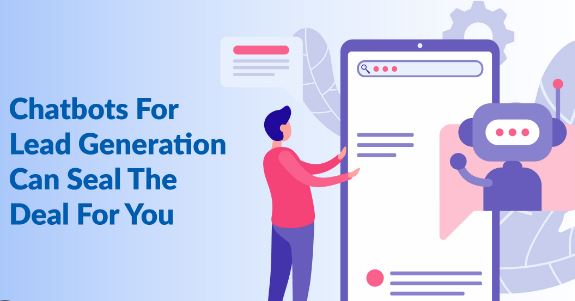How Can Chatbots Be Used for Lead Generation? Chatbots are becoming increasingly popular as a way to engage with customers and generate leads. They can be used on websites, in messaging apps, and even on social media.
There are many ways that chatbots can be used for lead generation. Here are a few of the most common:
- Qualifying leads: Chatbots can be used to qualify leads by asking them questions about their needs and interests. This information can then be used to determine which leads are most likely to convert into customers.
- Gathering contact information: Chatbots can be used to gather contact information from potential customers, such as their name, email address, and phone number. This information can then be used to follow up with leads and nurture them through the sales funnel.
- Promoting lead magnets: Chatbots can be used to promote lead magnets, such as ebooks, whitepapers, or free trials. This is a great way to attract new leads and get them to sign up for your email list.
- Answering questions: Chatbots can be used to answer questions from potential customers. This can help to build trust and credibility with leads, and it can also help to guide them through the buying process.
- Personalizing the customer experience: Chatbots can be used to personalize the customer experience by remembering past interactions with a lead. This can help to make leads feel like they are being treated like individuals, and it can also help to increase the chances of a sale.
How to Use Chatbots for Lead Generation
So how can you use chatbots for lead generation? Here are a few tips:
- Start with a clear goal: What do you want to achieve with your chatbot? Are you trying to qualify leads, gather contact information, or promote lead magnets? Once you know your goal, you can start to design your chatbot accordingly.
- Make your chatbot engaging: People are more likely to interact with a chatbot that is engaging and interesting. Use humor, storytelling, and other techniques to keep your chatbot’s conversations interesting.
- Personalize your chatbot: The more personalized your chatbot is, the more likely people are to trust it. Use your chatbot to remember past interactions with leads, and use this information to personalize the conversation.
- Track your results: It’s important to track the results of your chatbot so you can see what’s working and what’s not. Use analytics tools to track the number of leads generated, the number of sales closed, and other metrics.
FAQs
Q: What are the benefits of using chatbots for lead generation?
A: There are many benefits to using chatbots for lead generation, including:
- They can help you qualify leads more effectively. Chatbots can ask leads questions about their needs and interests, which can help you determine which leads are most likely to convert into customers. This can save you time and money by preventing you from chasing after leads that are not a good fit for your business.
- They can help you gather contact information from leads more easily. Chatbots can collect contact information from leads, such as their name, email address, and phone number. This information can then be used to follow up with leads and nurture them through the sales funnel. This can help you close more deals and grow your business.
- They can help you promote lead magnets more effectively. Chatbots can be used to promote lead magnets, such as ebooks, whitepapers, or free trials. This is a great way to attract new leads and get them to sign up for your email list. This can help you build your email list and generate more leads for your business.
- They can help you personalize the customer experience. Chatbots can be used to personalize the customer experience by remembering past interactions with a lead. This can help to make leads feel like they are being treated like individuals, and it can also help to increase the chances of a sale. This can help you build stronger relationships with your leads and customers.
- They can help you automate your lead generation process. Chatbots can automate many of the tasks involved in lead generation, such as qualifying leads, gathering contact information, and promoting lead magnets. This can free up your time so you can focus on other aspects of your business.
Q: What are the challenges of using chatbots for lead generation?
A: There are a few challenges to using chatbots for lead generation, including:
- They can be difficult to set up and configure. Chatbots can be complex to set up and configure. This is especially true if you want to create a chatbot that is personalized and engaging.
- They can be expensive to develop and maintain. The cost of developing and maintaining a chatbot can vary depending on the complexity of the chatbot and the features you want it to have.
- They can be difficult to train to be effective. Chatbots need to be trained to be effective. This can be a time-consuming process, and it can be difficult to get the chatbot to respond in a way that is natural and engaging.
- They can be perceived as being impersonal or robotic. Some people may perceive chatbots as being impersonal or robotic. This can be a challenge if you want your chatbot to build relationships with leads and customers.
Q: How can I avoid the challenges of using chatbots for lead generation?
A: There are a few things you can do to avoid the challenges of using chatbots for lead generation:
- Start with a clear goal. What do you want to achieve with your chatbot? Are you trying to qualify leads, gather contact information, or promote lead magnets? Once you know your goal, you can start to design your chatbot accordingly.
- Use a chatbot platform that is easy to use and configure. There are many chatbot platforms available, so you should choose one that is easy to use and configure. This will help you avoid the challenge of setting up and configuring your chatbot.
- Use a chatbot that is personalized and engaging. Your chatbot should be personalized to the individual user. This will help you avoid the challenge of your chatbot being perceived as being impersonal or robotic.
- Train your chatbot effectively. Your chatbot should be trained to respond in a way that is natural and engaging. This will help you avoid the challenge of your chatbot not being effective.
Q: What are some examples of chatbots that are used for lead generation?
A: Here are a few examples of chatbots that are used for lead generation:
- HubSpot’s chatbot helps businesses qualify leads by asking them questions about their needs and interests.
- Chatfuel’s chatbot helps businesses gather contact information from leads by asking them to sign up for an email list or download a whitepaper.
- ManyChat’s chatbot helps businesses promote lead magnets by offering free trials or discounts to leads who sign up for their chatbot.
These are just a few examples of chatbots that are used for lead generation. There are many other chatbots that can be used for this purpose.
Conclusion
Chatbots can be a powerful tool for lead generation. If you’re looking for a way to automate your lead generation process and improve your conversion rates, then chatbots are worth considering.
If you like to find our more about chatbots and lead generation, visit our webpage here, or book a demo with us.


